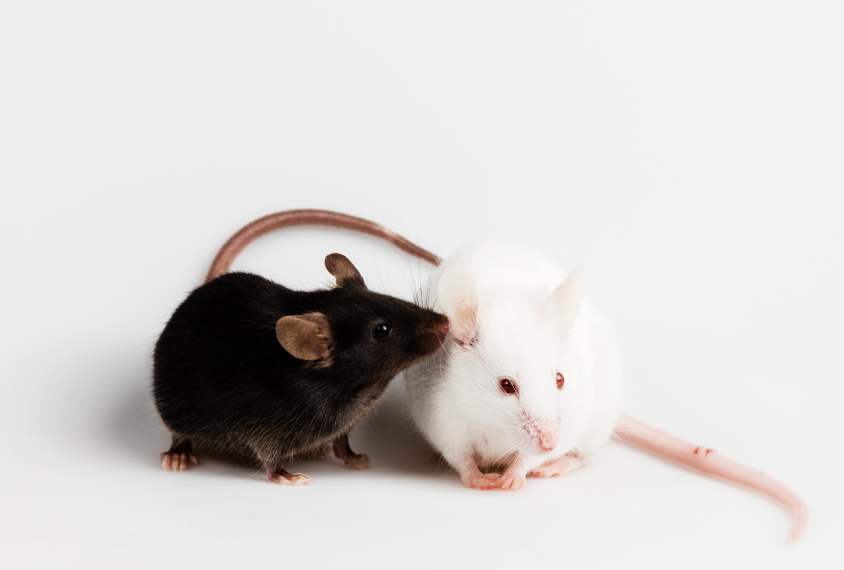
Anxiety drug reverses problems in mice with autism mutation
A widely used treatment for anxiety can eliminate some of the cognitive and social problems seen in mice missing a copy of ARID1B, a gene associated with autism.
A widely used anxiety drug can eliminate some of the cognitive and social problems seen in mice missing a copy of ARID1B, a gene associated with autism1.
The drug, clonazepam, boosts inhibitory brain activity. In addition to behavioral problems, the mutant mice have fewer neurons that suppress brain activity than controls do. So drugs such as clonazepam that ramp up inhibition may improve their function.
The results also hint at a treatment for people with mutations in ARID1B.
“For autism or intellectual disability associated with this ARID1B gene mutation, these drugs may be effective for those people,” says lead investigator Woo-Yang Kim, associate professor of developmental neuroscience at University of Nebraska Medical Center in Omaha. “This gene mutation is one of the most frequently found gene mutations in autism.”
Kim’s team is one of three in the past year that have debuted mice with only one functional copy of ARID1B2,3. All three teams have reported that their mice display impaired social behavior and anxiety, but Kim and his colleagues are the first to document cognitive problems. They are also the first to identify a decrease in inhibitory neurons as a potential cause of the behavioral traits.
ARID1B regulates the expression of other genes in the brain. But it has not been clear how its dysfunction leads to autism or intellectual disability.
“It’s a really well-done paper,” says Maria Chahrour, assistant professor of neuroscience and psychiatry at the University of Texas Southwestern Medical Center in Dallas. “They were able to specifically pinpoint the defect — I think that’s a nice mechanistic contribution.” Chahrour was part of one of the other two teams that created ARID1B mice.
Weak signals:
Kim and his colleagues deleted one copy of the ARID1B gene in mice. The mutant mice perform worse than controls on several learning and memory tasks. They also spend less time interacting with unfamiliar mice, groom themselves excessively and display other signs of anxiety.
The researchers counted the number of neurons in images of brain sections from the mice. They found that the mutants have fewer of one type of interneuron, a neuron that relays signals between other neurons, than controls do. These particular interneurons produce the inhibitory neurotransmitter gamma-aminobutyric acid (GABA), which dampens brain activity.
The researchers also compared neuronal activity in brain slices from the two groups of mice. They found that both groups have equivalent signals from neurons that tend to boost brain activity. But signals from inhibitory neurons are weaker in the mutants than in controls.
The results suggest that the brains of ARID1B mice have too little inhibitory activity, which could underlie their behavioral symptoms.
“Excitatory neurons and inhibitory neurons need to be balanced in the brain, and disrupting that balance will lead to some abnormal behaviors,” Kim says.
Restoring balance:
Kim and his colleagues then injected the mutant mice with clonazepam, a treatment for anxiety and seizures that enhances GABA activity. Treated mice perform better on a test involving recognizing objects and spend as much time interacting with unfamiliar mice as controls do. Their anxiety also declined to the level of typical mice. The work appeared 6 November in Nature Neuroscience.
The drug also boosts inhibitory signaling in brain slices from the mice. “If you enhance GABA activity with this drug, it will compensate for the shortage of GABA neurons in the brain,” Kim says.
The results may present new opportunities for treating people with ARID1B mutations, says Gijs Santen, a clinical geneticist at Leiden University Medical Center in the Netherlands, who was not involved in the research.
Knowing the ideal dose and timing of the treatment would require further study, Santen says, and the medication may not be able to fix problems in the brain that arose during development. But moving to the clinic should be straightforward because clonazepam is already approved for use in people and has few side effects.
References:
Recommended reading

New organoid atlas unveils four neurodevelopmental signatures
Explore more from The Transmitter

The Transmitter’s most-read neuroscience book excerpts of 2025

Neuroscience’s leaders, legacies and rising stars of 2025


